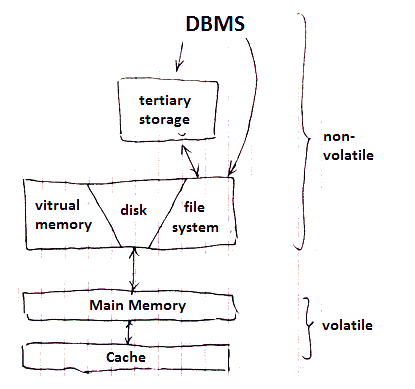The Memory Hierarchy

Two main categories:
- '’volatile’’: forgets what it stores when power goes off
- '’non-volatile’’: can persist data for a long time
Normally data is moved only between adjacent levels of hierarchy
Cache
- size: 1 mb or more
- access time: a few nanoseconds
data and instructions are moved to cache from the main memory when they are needed by the CPU
Main Memory
- to more from memory to cache/processor: 10-100 nanoseconds
stores all data and instructions
Secondary Storage
- 10 milliseconds to transfer data from disk to memory
'’Secondary storage’’: disks and other devices that can store large amounts of data
Virtual Memory
'’Virtual Memory’’ is an address space (32 or 64 bits)
- the OS manages VM keeping needed parts at hand (in the main memory)
- and the rest on disk
So beware: data can be moved to and fro by the OS| | |### Tertiary Storages
- very high read/write times
- may be optical disks stored somewhere
a storage with very large capacity (petabytes, etc)
See also
Sources
- Database Systems: The Complete Book (2nd edition) by H. Garcia-Molina, J. D. Ullman, and J. Widom